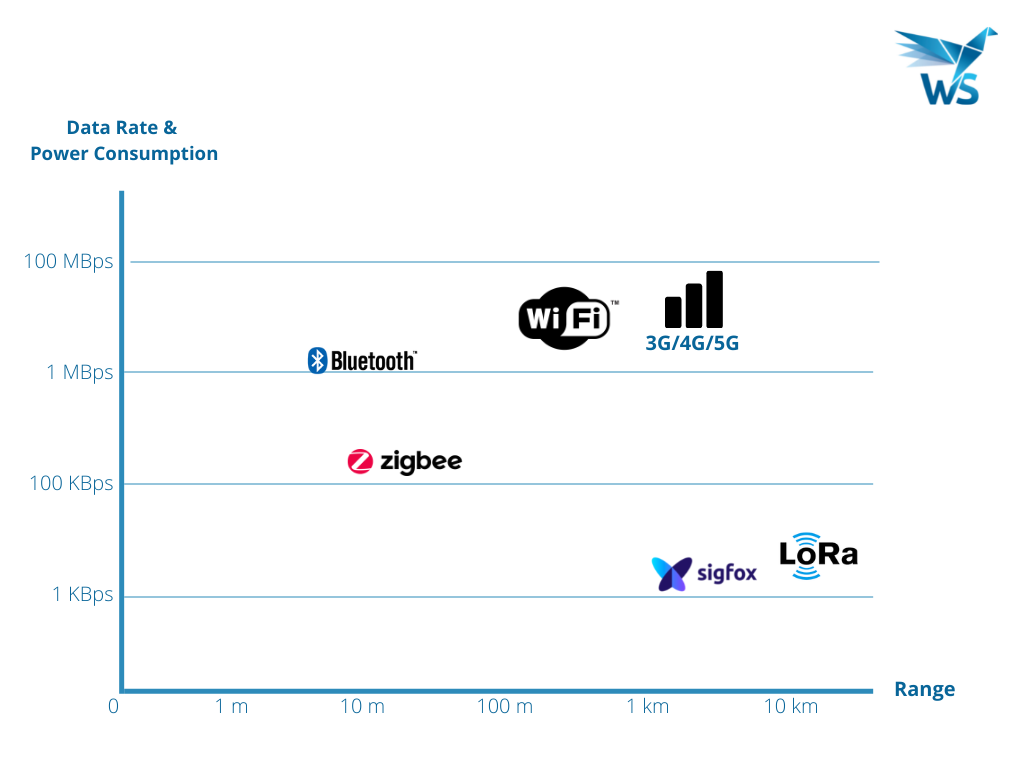
Since the British Kevin Ashton coined the term ‘Internet of Things’ in 1999, its application has spread like wildfire thanks to the development of communication technologies and the increase in Internet connections in the last two decades.
In the connected world in which we live, the IoT, or Internet of Things, is already a mature technology. It has with applications in almost all sectors and areas of our lives. In fact, it is estimated that there are currently more than 8 billion IoT devices. In 2030 this number will exceed 25 billion units. As for its value in the world market, it is estimated to reach a value of 1.1 trillion dollars in revenue in 2024, according to a study by Globaldata.
In this post we talk about this technology, its possibilities and the most used IoT communication protocols.
What are we talking about when we talk about IoT?
The IoT describes a network of physical devices connected to the Internet. They are able to interact and communicate with data management and/or processing systems. In some cases, the devices also communicate with each other, although this is not as common. This technology enables almost infinite practical applications in industrial, home automation, health, energy, logistics, banking, and a long etcetera. In fact, we can connect to the Internet practically any physical object. However, at WoodSwallow we are in favor of not giving in to the ‘connect for connect’ craze simply because it is technologically feasible. First we must ask ourselves what real value such connection brings. For this reason, we recommend not launching connected devices on the market without having carried out an in-depth analysis of their technical and business viability.
Advantages of converting an object into an IoT device
In any case, there is no doubt that IoT devices offer a huge number of advantages and benefits. They favor the emergence of new business models and new services, as well as increased productivity and cost savings. In addition, they improve the user experience or the flexibility and agility when making decisions, among many other advantages.
Providing connectivity to a device allows us to collect the data generated and send it to the network for later analysis, although there are cases in which the device itself analyzes or processes the information to then broadcast it. If we talk about embedded systems (physical devices designed to fulfill one or a few specific functions), the evolution towards IoT devices is, in many cases, very convenient.
For example, we may have a series of humidity sensors deployed throughout a factory. These could simply fulfill their function by themselves. However, if we go one step further and turn them into connected devices, we will be able to collect the data and monitor the activity of the sensors remotely and in real time. We would no longer need to manually collect the data from each sensor. This, with the consequent investment in time, personnel, and effort that this entails. Without a doubt, it is a substantial leap that favors decision-making in a more agile and efficient way, as well as significant savings in time and costs, among others.
IoT security
The security aspect also deserves a special mention. It should not be forgotten that providing connectivity to physical devices implies a series of security, privacy and regulatory compliance challenges that must be considered throughout the entire definition, design, development and maintenance process of any IoT device.
Something that differentiates our understanding of cybersecurity and IoT security is that, to talk about IoT security, cybersecurity must be considered from the point of view of the software itself, but also the security of the physical device, the hardware. The latter is often forgotten, causing security breaches that could have been avoided.
IoT communication protocols
When deploying an IoT environment, we must decide which IoT communication protocol is the most appropriate. This will be the one that allows communication between the devices and the data management and/or processing systems; that is, Machine2Machine (M2M) communication. There are different types of protocols depending on the type of IoT devices that need to be connected and the communication needs of each case.
Regarding the most common wireless communication protocols today, we can distinguish between protocols according to their range capacity and their data rate and energy consumption. If what we need is to transmit a large amount of data over a short distance, the protocol we need will be different from the one we would choose if what we are looking for is to transmit a smaller amount of data, but at a greater distance. Another aspect to consider is the power source of the device. If this is powered by a battery, we will need it to be much more energy efficient than if it were connected to the network. Each technology has its strengths and weaknesses so, when deciding which IoT protocol is the most suitable for our IoT device, we must weigh several factors.

Bluetooth
Bluetooth technology is a short-range IEE.802.15 wireless communication standard protocol that is widely used in the consumer market. Originally, it was designed for the transmission of data between two digital devices (between a computer and wireless headphones, for example). In some cases, the connection is made from one device to multiple devices simultaneously. Its operating range is approximately 10 meters (although in some cases it may be greater) and it operates in the 2.4 GHz band.
Since its introduction, more than 20 years ago, many versions have been developed, progressively improving this technology, the most recent version being Bluetooth 5.3, recently released. This version brings important advances in terms of performance improvement, better user experience and, above all, energy consumption. This last point, that of reducing energy consumption, is specially designed for IoT.
Currently this technology is widely used, for example, in the retail sector, since it allows indoor location, facilitating new possibilities such as geolocation within the store and personalized advertising, among others.
ZigBee
ZigBee is a low-power, short-range wireless standard (IEE 802.15.4). Unlike Bluetooth, the communication is not point-to-point, but works on a mesh network where the network connection is shared between wireless nodes that communicate with each other and share a network connection over a wide area.
Due to its short range (less than 100 meters), its use is suitable for IoT applications with low-power devices that do not require much bandwidth and are located at a short distance. It is also recommended for secure communication needs, with a low data rate and low power consumption (which favors extending the useful life of the batteries).
The ZigBee protocol is increasingly used in home automation environments, along with Wi-Fi technology. For example, for smart lighting uses, energy management, home security, etc.
Wi-Fi
This is, without a doubt, one of the most recognized protocols on this list. In recent years, its use has spread widely in both domestic and business environments. Its disadvantage is that it has limitations in terms of coverage, scalability, and power consumption.
Since it has high power consumption, it is not appropriate for devices where access to power is limited, such as battery-powered IoT devices.
The latest generation that is being worked on and that will begin to be implemented from next year is Wi-Fi 7 (officially IEEE 802.11be). This incorporates significant improvements over the current generation. Specifically, it considerably increases the speed (it is believed that it reaches a maximum speed of up to 40 Gigabytes per second), it will have lower latency and greater capacity, stability, and efficiency. In fact, it will support up to 320 MHz bandwidth, which means doubling the current data transmission capacity.
Its combination of very high speed and low latency will make this new generation have, even more so, important applications in both home, industrial and office networks. For example, in the field of augmented reality or video games.
Sigfox
Sigfox is a long-range, low-power wireless technology that was patented by the Sigfox company and is now in the public domain. Although not as widespread, Sigfox plays a role in the IoT world as it is very appropriate for certain uses in industry, transport, logistics, public services, energy, health, and agriculture.
This technology allows information to be transmitted from devices over the Internet with low consumption thanks to the fact that they do not have a high data rate and that it uses ultra-narrow band (UNB) technology to save energy. In addition, it makes it possible to transmit information between devices located at a great distance, being able to reach up to 5 kilometers.
Another characteristic is that, sometimes, they do not need to have a power supply, but are powered by batteries that allow them to function for years. In general, it is an effective and efficient technology, widely used in non-critical IoT applications.
LoRa
LoRa (an acronym for Long Range) is a low-power, long-range wireless protocol. Semtech is the owner of this technology. It uses a radio frequency modulation technique known as Chirp Spread Spectrum (CSS). What this technology does is transmit information between devices in the form of radio waves.
LoRa stands out from other long-range, low-power (LPWAN) technologies for having an open-source physical layer (PHY) that provides long-range, low-power communication devices. The fact that it is open source allows more developers to participate in its development, which favors that the final result is more tested and more robust.
As for its applications, we find many examples such as water and gas meters, public lighting, waste management, Smart energy or agriculture.
Cellular (3G/4G/5G)
We have widely used Cellular technology for decades. Its greatest strength lies in its ability to deliver highly reliable broadband communications. On the contrary, its energy consumption and operating costs are quite high.
As in the case of Wi-Fi technology, its high energy consumption makes it a technology that is not recommended for battery powered IoT devices. However, it is very appropriate for other use cases in which it is necessary to connect IoT devices far removed from each other, such as vehicle fleet management or the logistics sector.
Special mention deserves the new generation; 5G. With its ultra-low latency and high speed, which positions it as the technology of the future for connected and autonomous mobility, as well as for augmented reality, among many other applications in the field of security, health or industry.
At this point, we cannot fail to mention two technologies that are very popular lately: LTE-M and NB-IoT cellular networks. Both are Low Power Wide Area (LPWA) technologies designed for IoT applications. They facilitate internet connection for devices that only need to transmit small amounts of data at low cost and in a way that optimizes battery life. This makes both protocols very convenient for multitude applications with these needs, which is why an important development of both technologies is expected in the coming years.
Conclusion: you should closely follow the evolution of the IoT
All of the above are small brushstrokes of what is actually a complex and changing world. Every day new technologies are developed and new applications and business opportunities are discovered. Precisely because of their possibilities and implications, it is key to closely follow all the news about these technologies at the hands of experts capable of guiding and advising you.
At WoodSwallow we have a team of hardware and firmware engineers. We have over 15 years of experience designing hardware and software for IoT products and embedded systems. Contact us and we will advise you on your IoT project, and on the type of communication protocol that best suits your product.






